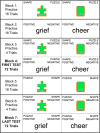Do puzzle pieces and autism puzzle piece logos evoke negative associations?
- PMID: 28823194
- PMCID: PMC6085079
- DOI: 10.1177/1362361317727125
Do puzzle pieces and autism puzzle piece logos evoke negative associations?
Abstract
Puzzle pieces have become ubiquitous symbols for autism. However, puzzle-piece imagery stirs debate between those who support and those who object to its use because they believe puzzle-piece imagery evokes negative associations. Our study empirically investigated whether puzzle pieces evoke negative associations in the general public. Participants' ( N = 400) implicit negative associations were measured with an Implicit Association Task, which is a speeded categorization task, and participants' explicit associations were measured with an Explicit Association Task, which is a standard task for assessing consumers' explicit associations with brands (and images of those brands). Puzzle pieces, both those used as autism logos and those used more generically, evoked negative implicit associations ( t(399) = -5.357, p < 0.001) and negative explicit associations ( z = 4.693, p < 0.001, d = 0.491). Participants explicitly associated puzzle pieces, even generic puzzle pieces, with incompleteness, imperfection, and oddity. Our results bear public policy implications. If an organization's intention for using puzzle-piece imagery is to evoke negative associations, our results suggest the organization's use of puzzle-piece imagery is apt. However, if the organization's intention is to evoke positive associations, our results suggest that puzzle-piece imagery should probably be avoided.
Keywords: IAT; Implicit Association Test; free associations; puzzle.
Conflict of interest statement
Declaration of conflicting interests
The author(s) declared no potential conflicts of interest with respect to the research, authorship, and/or publication of this article.
Figures




References
-
- Acosta MT, Pearl PL. The neurobiology of autism: new pieces of the puzzle. Current Neurology and Neuroscience Reports. 2003;3:149–156. - PubMed
-
- Brook K. A response to ‘notes on a puzzle piece’. Autism. 2016;20:251–252. - PubMed
-
- CNRS. Missing piece surfaces in the puzzle of autism. ScienceDaily. 2015 Available at: https://www.sciencedaily.com/releases/2015/08/150804074037.htm.
-
- Crawford C. Solving the autism spectrum puzzle. Alaska Special Education Service Area Newsletter. 2004;62(2):2–4.
MeSH terms
Grants and funding
LinkOut - more resources
Full Text Sources
Other Literature Sources

